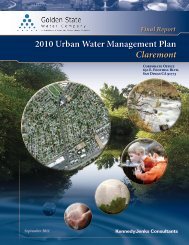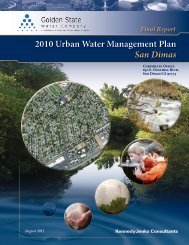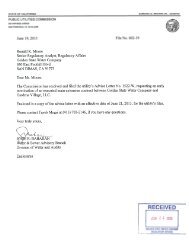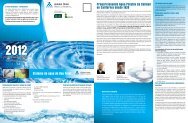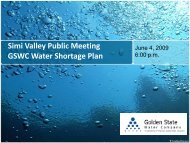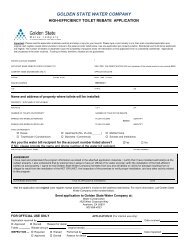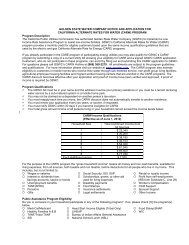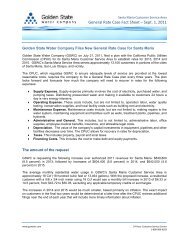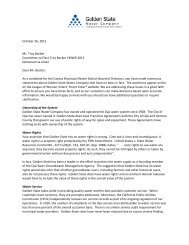Final Report, 2010 Urban Water Management Plan - Culver City
Final Report, 2010 Urban Water Management Plan - Culver City
Final Report, 2010 Urban Water Management Plan - Culver City
You also want an ePaper? Increase the reach of your titles
YUMPU automatically turns print PDFs into web optimized ePapers that Google loves.
Guidebook to Assist <strong>Urban</strong> <strong>Water</strong> Suppliers to Prepare a <strong>2010</strong> <strong>Urban</strong> <strong>Water</strong> <strong>Management</strong> <strong>Plan</strong>(DWR Guidebook) issued March 2011. The three overall steps to determine the 2020 water usetarget are as follows:• Step 1 – Calculate the baseline per capita water use, using the required methodologies.• Step 2 – Calculate the per capita reduction using at least one of the four methodologies(including the minimum reduction target – which is a provision included to ensure allagencies achieve a minimum level of water savings).• Step 3 – Select the target reduction methodology and set interim (2015) and compliance(2020) water use targets. The chosen methodology is the responsibility of the water supplierand may be changed in 2015.The Act now stipulates that the state shall review the progress made towards reaching thestatewide water savings targets as reported in the 2015 UWMP updates. Currently, no singleurban water supplier is required to conserve more than 20 percent; however there areprovisions in the law that could require additional conservation after 2015 if it is found that theprogram is not on track to reach 20 percent statewide water savings by 2020.3.2.1 Baseline Per Capita <strong>Water</strong> UseThe first step in the process of determining the water use target is calculation of the baseline percapita water use (baseline gpcd). In order to calculate the baseline gpcd, service areapopulation within the <strong>Culver</strong> <strong>City</strong> System was estimated and compared to actual water userecords. The following three baseline gpcd calculation methods identified in SBX7-7 wereevaluated for the <strong>Culver</strong> <strong>City</strong> System:1. Baseline Method 1 – Average water use over a continuous 10-year period ending no earlierthan December 31, 2004 and no later than December 31, <strong>2010</strong>.2. Baseline Method 2 – For retailers with at least 10 percent of 2008 demand served byrecycled water (either retail-or wholesale-provided), this calculation may be extended toinclude an additional 5 years ending no earlier than December 31, 2004 and no later thanDecember 31, <strong>2010</strong>.3. Baseline Method 3 – Estimate of average gross water use reported in gpcd and calculatedover a continuous 5-year period ending no earlier than December 31, 2007 and no later thanDecember 31, <strong>2010</strong>.The baseline Methods 1 and 3 were calculated using GSWC supply data for the years endingDecember 31, 1997 through December 31, <strong>2010</strong>. The base water use was calculated for eachyear commencing with 1997 as this was the first year with production data records available.The <strong>Culver</strong> <strong>City</strong> system does not currently receive recycled water; therefore Baseline Method 2is not applicable. Table 3-2 below presents the base period ranges, total water deliveries andthe volume of recycled water delivered in 2008; these data are used to determine the number ofyears that can be included in the base period range. Also shown are the actual start and endyears for the selected base period range.Page 3-4<strong>Final</strong> <strong>Report</strong>, <strong>2010</strong> <strong>Urban</strong> <strong>Water</strong> <strong>Management</strong> <strong>Plan</strong> – <strong>Culver</strong> <strong>City</strong>Golden State <strong>Water</strong> Companyg:\adminasst\jobs\<strong>2010</strong>\1070001.00_gswc-uwmp\09-reports\9.09-reports\2011-08\grp3\gswc_culvercity_<strong>2010</strong>_uwmp-final.doc




